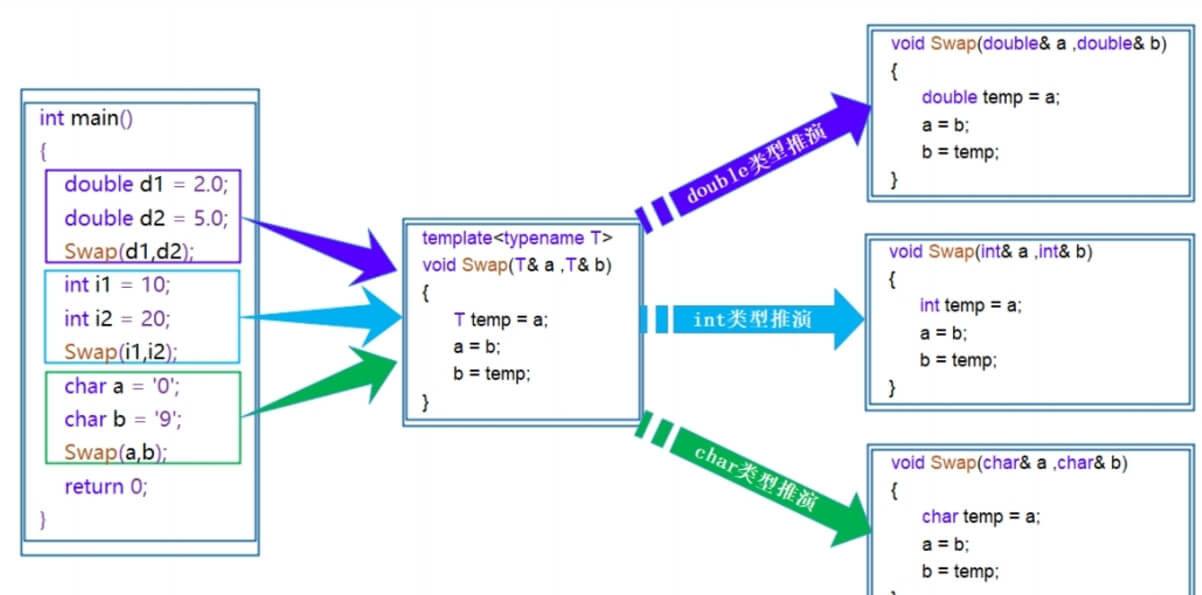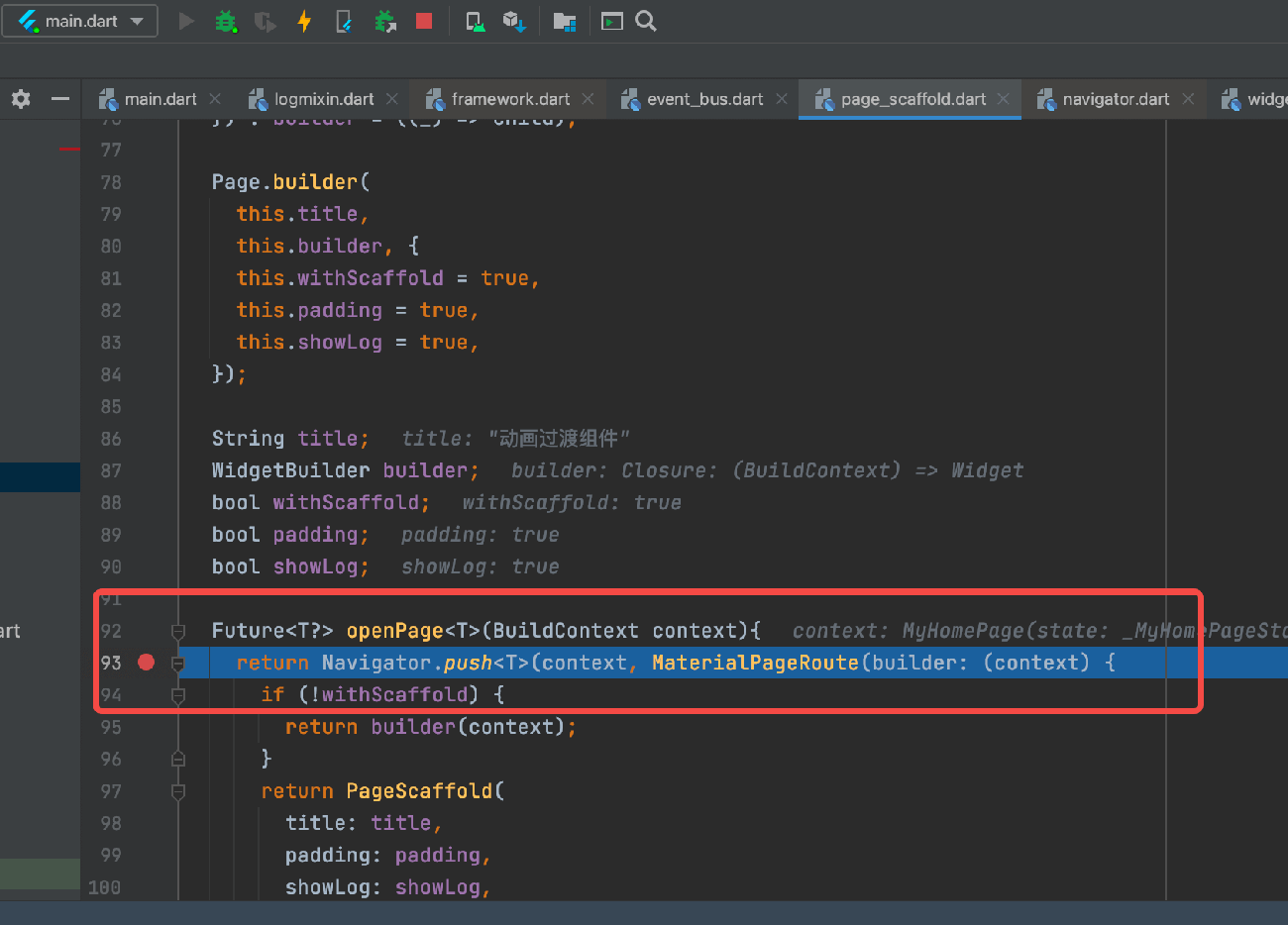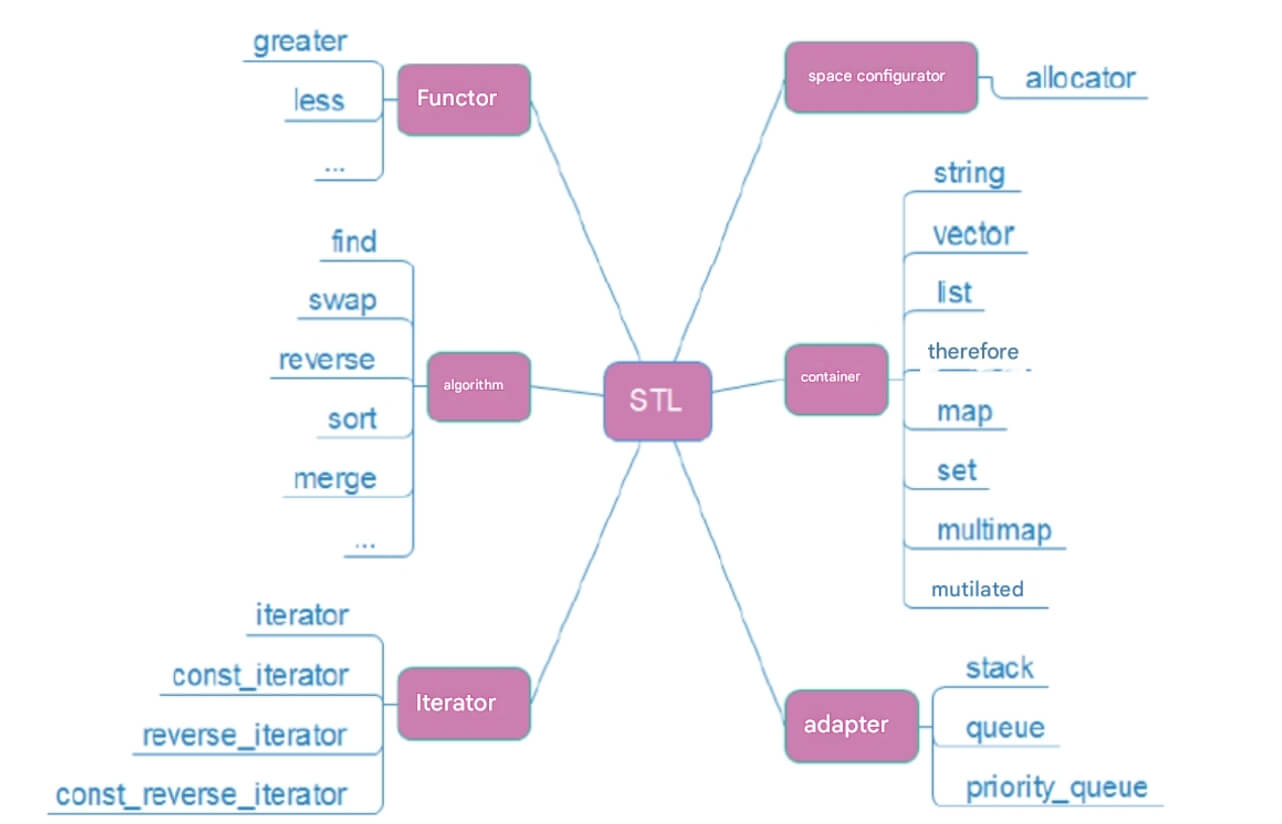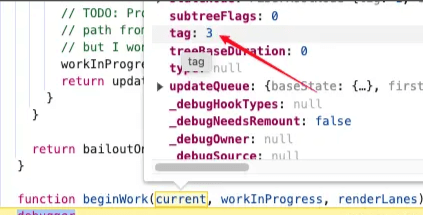In C++ programming, templates are a key tool for implementing generic programming. Templates allow code to be applicable to different data types, significantly enhancing code reusability, flexibility, and maintainability. This article will delve into the basics of template programming, including the definition and usage of function templates and class templates, as well as their instantiation and matching rules.
1. Core Ideas of Generic Programming and Templates
1.1 What is Generic Programming?
Generic programming is the practice of writing general code that is independent of data types, serving as a means for code reuse. Templates form the foundation of generic programming.
Generic Programming is an approach aimed at making code applicable to multiple data types. Using templates, programmers can write code once and apply it to various data types without changing the original code. In C++, templates are the fundamental tool for implementing generic programming.
1.2 Why Use Generic Programming?
The emergence of generic programming aims to address issues of code reuse and maintainability. Suppose we want to implement a function to swap two variables:
void Swap(int& a, int& b) {
int temp = a;
a = b;
b = temp;
}This code can only swap int type variables. If we need to support double or char, we must overload the function:
// Swap two double values
void Swap(double& a, double& b) {
double temp = a;
a = b;
b = temp;
}
// Swap two characters
void Swap(char& a, char& b) {
char temp = a;
a = b;
b = temp;
}This approach has the following drawbacks:
Code Redundancy: Each new data type requires adding an overloaded function, increasing code duplication.
Poor Maintainability: If the swap logic has a bug, it could affect all overloaded functions.
Templates allow us to write a single generic swap function that works for multiple data types, solving these problems.
2. Basics of Function Templates
2.1 What is a Function Template?
A function template is a mechanism that allows a function to be applicable to multiple data types. By defining template parameters, the compiler automatically generates a specific version of the function based on the passed argument types. A function template can be seen as a blueprint for a "family of functions," with each member specialized for a certain data type. When calling a function template, the compiler deduces the type parameters and generates the corresponding function code.
2.2 Syntax for Defining a Function Template
The syntax for defining a function template is as follows:
template<typename T1, typename T2, ..., typename Tn>
ReturnType FunctionName(ParameterList) {
// Function body
}In this format:
template<typename T1, typename T2, ..., typename Tn>defines the template parameters, wheretypenameindicates that the parameters are types (you can also useclassinstead oftypename, but notstruct).T1, T2, ...are placeholder types, and the actual types are deduced by the compiler when the function is called.
Example: Implementing a generic Swap function
template<typename T>
void Swap(T& left, T& right) {
T temp = left;
left = right;
right = temp;
}This function template allows us to swap variables of any type. For example:
int a = 1, b = 2; Swap(a, b); // Compiler deduces T as int double x = 1.1, y = 2.2; Swap(x, y); // Compiler deduces T as double
The compiler automatically generates the appropriate Swap function based on the argument types.
2.3 How Function Templates Work
A function template is a blueprint. It is not a function itself; the compiler generates a specific function of a particular type when the template is used. Essentially, templates delegate the task of generating repetitive code to the compiler.

During compilation, the function template generates the corresponding function version based on the argument types. This process is called template instantiation. When using the double type with the Swap function template, the compiler deduces the template parameter T as double and generates a version of the function for double. Similarly, when using int, the compiler generates a version for int.
This approach improves code reusability and avoids the need for multiple overloaded functions for different data types.
2.4 Function Template Instantiation
When we use a function template, the compiler needs to generate the corresponding function version based on the actual argument types. This process is known as template instantiation, and it can be implicit or explicit.
Implicit Instantiation: The compiler automatically deduces the template parameters based on the argument types and generates the corresponding code.
template<class T>
T Add(const T& left, const T& right) {
return left + right;
}
int main() {
int a1 = 10, a2 = 20;
double d1 = 10.0, d2 = 20.0;
Add(a1, a2); // Implicit instantiation for Add<int>
Add(d1, d2); // Implicit instantiation for Add<double>
}Explicit Instantiation: Manually specify the template parameter types after the function name using angle brackets (
< >) to generate a specific template instance.
int main() {
int a = 10;
double b = 20.0;
Add<int>(a, static_cast<int>(b)); // Explicit instantiation for Add<int>
}Explicit instantiation is useful when automatic type deduction is not possible or when specific types are needed.
2.5 Template Parameter Matching Rules
In C++, the compiler chooses whether to call a non-template function or generate a template function instance based on parameter types. The following are the matching rules:
Non-template Functions Take Priority Over Template Functions: If both a non-template function and a template function with the same name exist, the compiler will prefer the non-template function if the argument types match exactly.
int Add(int a, int b) { return a + b; }
template<typename T>
T Add(T a, T b) { return a + b; }
int main() {
int a = 10, b = 20;
double x = 1.1, y = 2.2;
Add(a, b); // Calls the non-template function Add(int, int)
Add(x, y); // Calls the template function Add<double>(double, double)
}Template Versions Provide Better Matching: If both non-template and template functions can handle the argument types, but the template version offers a better match, the compiler will choose the template version.
double Add(double a, double b) { return a + b; }
template<typename T>
T Add(T a, T b) { return a + b; }
int main() {
int a = 10, b = 20;
double x = 1.1, y = 2.2;
Add(a, b); // Calls the template version Add<int>(int, int)
Add(x, y); // Calls the non-template function Add(double, double)
}No Implicit Type Conversions in Templates: In templates, the compiler will not perform implicit type conversions.
template<typename T>
T Add(T a, T b) { return a + b; }
int main() {
int a = 10;
double b = 20.0;
Add(a, b); // Error: Compiler can't implicitly convert a or b
}Handling Type Mismatches: If the template parameter types don't match, two solutions are available:
Explicit Conversion: Use
static_castto force the conversion of parameters to the required type.Explicit Instantiation: Manually specify the template parameter type to instantiate the required function.
Example:
Add(a, static_cast<int>(b)); // Convert b to int Add<int>(a, b); // Explicitly instantiate Add<int>
3. Basics of Class Templates
3.1 Concept of Class Templates
A class template allows us to create classes that are applicable to various data types. Similar to function templates, class templates use type parameters to generate specific types of classes. Class templates are often used to build data structures (such as stacks, queues, etc.), enabling them to store data of any type.
3.2 Syntax of Class Template Definition
Class templates allow us to create classes for different data types. Like function templates, class templates specify types in the class using template parameters. Class templates can be used to implement general data structures and algorithms, making the code more flexible and reusable.
The syntax for defining a class template is as follows:
template<typename T>
class ClassName {
public:
// Constructor, member functions
void Method();
private:
T memberVariable; // Member variable using template type
};In this format:
template<typename T>declares a template whereTis a type parameter, which can be used in the class as a member variable, function parameters, or return types.In the class definition,
Tacts as a placeholder that can represent any type. When the class template is instantiated,Tis replaced by the actual type, generating a specific class.
The flexibility of class templates makes them suitable for implementing general data structures such as stacks, queues, and linked lists. This eliminates code repetition and allows support for various data types while maintaining type safety.
3.3 Class Template Instantiation
Class templates are instantiated differently from function templates. When using a class template, the type parameter must be explicitly specified, meaning that when declaring a class template object, the type parameter must be provided within angle brackets < > after the class name. The compiler generates the corresponding class code based on the specified type parameter.
For example:
Stack<int> intStack; // Instantiating a stack for int type Stack<double> doubleStack; // Instantiating a stack for double type
3.4 Example: Generic Stack Class Template
Below is a simple Stack class template that supports stack operations for any type:
#include <iostream>
using namespace std;
template<typename T>
class Stack {
public:
// Constructor to initialize stack capacity
Stack(size_t capacity = 10) : _capacity(capacity), _size(0) {
_array = new T[capacity];
}
// Push element onto stack
void Push(const T& data) {
if (_size < _capacity) {
_array[_size++] = data;
} else {
Expand();
_array[_size++] = data;
}
}
// Pop element from stack
void Pop() {
if (_size > 0) {
--_size;
}
}
// Return top element of stack
T& Top() const {
if (_size > 0) {
return _array[_size - 1];
}
throw out_of_range("Stack is empty");
}
// Check if stack is empty
bool IsEmpty() const {
return _size == 0;
}
// Destructor to release dynamically allocated memory
~Stack() {
delete[] _array;
}
private:
T* _array; // Array to store stack elements
size_t _capacity; // Stack capacity
size_t _size; // Current number of elements in stack
// Expand stack capacity
void Expand() {
size_t newCapacity = _capacity * 2;
T* newArray = new T[newCapacity];
for (size_t i = 0; i < _size; ++i) {
newArray[i] = _array[i];
}
delete[] _array;
_array = newArray;
_capacity = newCapacity;
}
};Using the Stack Class Template
When using a class template, we must specify the stack's data type. For example, Stack<int> represents a stack that stores int values, and Stack<double> represents a stack that stores double values:
int main() {
Stack<int> intStack; // Create a stack for int type
intStack.Push(10);
intStack.Push(20);
cout << "Top element: " << intStack.Top() << endl; // Output 20
intStack.Pop();
cout << "Top element after pop: " << intStack.Top() << endl; // Output 10
Stack<double> doubleStack; // Create a stack for double type
doubleStack.Push(1.5);
doubleStack.Push(2.5);
cout << "Top element: " << doubleStack.Top() << endl; // Output 2.5
return 0;
}In this example:
Stack<int> intStackdeclares a stack forinttype, whereintStackaccepts onlyintelements.Stack<double> doubleStackdeclares a stack fordoubletype, wheredoubleStackaccepts onlydoubleelements.
The compiler generates a specific instance of the Stack class for int and double types, allowing code reuse.
3.5 Separation of Declaration and Definition of Class Templates
In C++, if the declaration and definition of a class template are separated into different files (e.g., declaration in a header file .h and definition in a source file .cpp), it can lead to linking errors. This is because the template code is used to generate specific types during compilation, and the template definition is only instantiated when needed.
Therefore, the implementation and declaration of a template class are generally placed in the same header file so that each compilation unit using the template can see the full definition. Otherwise, linking errors may occur when the template definition cannot be found during the linking phase.
Example: Declaration and definition in the same header file
// Stack.h
#ifndef STACK_H
#define STACK_H
#include <stdexcept>
template<typename T>
class Stack {
public:
Stack(size_t capacity = 10);
void Push(const T& data);
T Pop();
T& Top() const;
bool IsEmpty() const;
~Stack();
private:
T* _array;
size_t _capacity;
size_t _size;
void Expand();
};
// Constructor definition
template<typename T>
Stack<T>::Stack(size_t capacity) : _capacity(capacity), _size(0) {
_array = new T[capacity];
}
// Push method definition
template<typename T>
void Stack<T>::Push(const T& data) {
if (_size == _capacity) {
Expand();
}
_array[_size++] = data;
}
// Pop method definition
template<typename T>
T Stack<T>::Pop() {
if (_size > 0) {
return _array[--_size];
}
throw std::out_of_range("Stack is empty");
}
// Top method definition
template<typename T>
T& Stack<T>::Top() const {
if (_size > 0) {
return _array[_size - 1];
}
throw std::out_of_range("Stack is empty");
}
// IsEmpty method definition
template<typename T>
bool Stack<T>::IsEmpty() const {
return _size == 0;
}
// Expand method definition
template<typename T>
void Stack<T>::Expand() {
size_t newCapacity = _capacity * 2;
T* newArray = new T[newCapacity];
for (size_t i = 0; i < _size; ++i) {
newArray[i] = _array[i];
}
delete[] _array;
_array = newArray;
_capacity = newCapacity;
}
// Destructor definition
template<typename T>
Stack<T>::~Stack() {
delete[] _array;
}
#endif // STACK_HBy placing both the declaration and definition in the same header file, we avoid issues with finding the template definition across different compilation units.
3.6 Class Template Instantiation and Advanced Applications
The flexibility of class templates makes them ideal for implementing general data structures, such as stacks, queues, linked lists, and arrays. Through class templates, we can support various data types with the same code, greatly improving code reuse and flexibility.
Example applications:
Stack (Stack<T>): Used to store different types of elements.
Queue (Queue<T>): Can implement a generic queue data structure that supports any type.
Dynamic Array (DynamicArray<T>): Can implement a dynamic array that supports add, remove, and resize operations.
Linked List (LinkedList<T>): Can implement a general linked list (singly or doubly linked) supporting nodes of any type.
Advantages:
Code Reuse: Write a class template once to support multiple data types.
Type Safety: The compiler checks types during instantiation to ensure code safety.
High Maintainability: Maintain the template code in one place, without having to modify it for each data type.
By effectively using class templates, C++ programs can implement more flexible and generic code structures, simplifying complex data handling tasks and making the code more efficient and elegant.
Summary
Templates in C++ provide powerful tools for implementing generic programming. Using function templates, we can generate function versions adapted to various data types, reducing code duplication and maintenance workload. Class templates offer an efficient way to implement generic data structures, making it easier for these structures to adapt to different data types. Special attention must be paid to details such as instantiation, template matching, and the separation of declaration and definition to correctly utilize template techniques. In future C++ projects, the flexible application of templates will help us write more efficient and versatile code.







